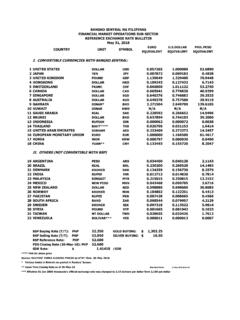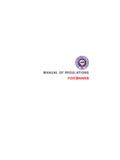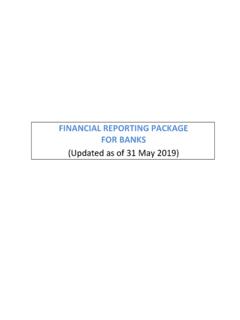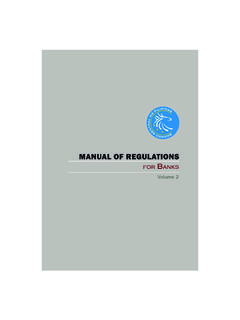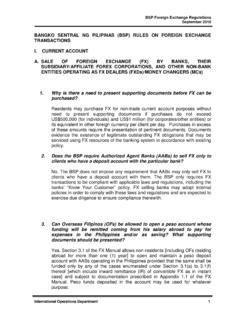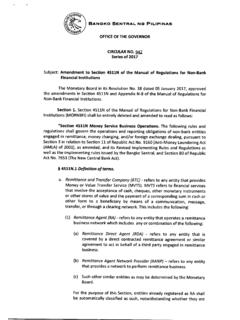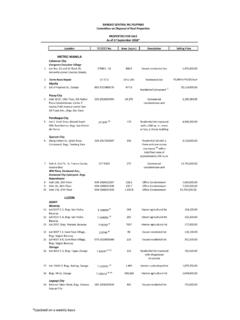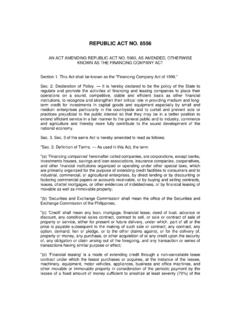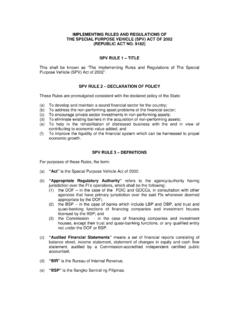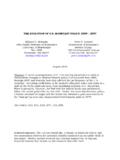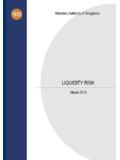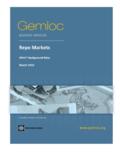Transcription of HIGHLIGHTS OF THE MEETING OF THE MONETARY BOARD …
1 MPSS Form No. 03-005 * Version 1 * Updated 06 March 2015 File/Ref. No. MPRG-100318-01 Page 1 of 4 I. MONETARY Policy Decision The MONETARY BOARD (MB) decided to: a) Increase the BSP s key policy interest rate by 50 basis points to percent for the overnight RRP (borrowing) facility, effective 28 September 2018; and, b) Adjust the interest rates on the overnight deposit and overnight lending facilities accordingly. II. Key Considerations in the Formulation of the MONETARY Policy Stance The MONETARY BOARD s decision to raise the BSP s policy interest rate anew was based on its assessment that a further tightening of MONETARY policy was warranted by persistent signs of sustained and broadening price pressures. Latest baseline forecasts have shifted higher for both 2018 and 2019, with risks to the outlook still leaning toward the upside.
2 Equally important, with supply-side forces expected to continue to drive inflation in the coming months, inflation expectations have remained elevated amid indications of second-round effects. Meanwhile, domestic demand conditions have generally held firm, even as the previous MONETARY policy responses continue to work their way through the economy. Given the considerations cited above, the MONETARY BOARD decided to raise the BSP policy interest rate anew to further anchor inflation expectations and to safeguard the inflation target over the policy horizon. The MONETARY BOARD believed that a tighter MONETARY policy stance will help steer inflation toward a target-consistent path over the medium term by reducing further risks to the inflation outlook, including those emanating from exchange rate volatility given the continued uncertainty in the external environment amid geopolitical tensions and the normalization of MONETARY policy in advanced economies.
3 The MONETARY BOARD likewise emphasized the need for timely and appropriate non- MONETARY measures that will further mitigate the impact of supply-side factors on inflation, including rice tariffication. The MONETARY BOARD reassured the public of the BSP s strong commitment to take all necessary policy actions to address the threat of high inflation and deliver on its primary mandate of price stability. 1 The discussions herein reflect the assessment made by the MONETARY BOARD based on a comprehensive set of economic information available at the time of the policy MEETING . The HIGHLIGHTS of the discussions during the 27 September 2018 MONETARY policy MEETING were approved by the MONETARY BOARD during its regular MEETING held on 18 October 2018. The next MEETING of the MONETARY BOARD on the MONETARY policy stance is scheduled on 15 November 2018.
4 HIGHLIGHTS OF THE MEETING OF THE MONETARY BOARD ON THE MONETARY POLICY STANCE HELD ON 27 September 20181 Page 2 of 4 III. Recent Developments and Inflation Outlook The MB considered the following developments in deciding on the MONETARY policy stance: A. Domestic price conditions Year-on-year headline inflation rose further to percent in August 2018 from percent in July 2018 using the 2012-based consumer price index (CPI) series. This brought the year-to-date average to percent, which is above the Government s announced inflation target range of percent percentage point for 2018. Similarly, core inflation readings are higher in August. The number of CPI items above the 4-percent threshold and the diffusion index of price changes have likewise increased compared to that in the previous month. B. Inflation expectations Mean inflation forecasts from surveys of private sector economists continued to show elevated inflation expectations for 2018-2020.
5 Preliminary results of the BSP s September 2018 survey of private sector economists showed higher mean inflation forecasts at percent for 2018 (from percent in the August survey), percent for 2019 (from percent), and percent for 2020 (from percent). Meanwhile, based on the survey conducted by Consensus Economics in August 2018, mean inflation forecasts are also higher at percent (from percent) for 2018 and percent (from percent) for 2019. C. Inflation outlook Compared with the previous forecast round, the latest baseline inflation forecasts for 2018 and 2019 were higher at percent and percent, respectively. Inflation forecast for 2020 was unchanged at percent. The risks to future inflation remain on the upside in 2018, but downside risks to the outlook are seen to dominate in 2019-2020 due largely to the projected impact of rice tariffication.
6 O Additional wage adjustments and transport fare hikes, higher electricity rates, and faster-than-expected MONETARY policy normalization in advanced economies are the main upside risks to inflation. o Meanwhile, the slower global economic growth due to protectionist policies in advanced economies and geopolitical tensions along with the proposed reform in the rice industry involving the replacement of quantitative restrictions with tariffs and the deregulation of rice imports continue to be the main downside risks to inflation. Baseline Inflation Forecasts 2012-based CPI 9 Aug MB 27 Sep MB 2018 2019 2020 Page 3 of 4 D. Demand conditions GDP growth moderated in the second quarter due to negative contribution of net exports, although the economy continued to grow above its historical average rate. Domestic demand remained generally firm with its contribution to headline growth the highest in seven quarters due to higher government spending and increased capital formation while household expenditure continued to slow down.
7 Meanwhile, most recent surveys show business and consumer sentiment turning less sanguine in the third quarter albeit still optimistic in the next few succeeding quarters. Nonetheless, the Philippine composite PMI remained above the 50-point expansion threshold at in August, the highest level since May 2016. Aggregate demand is also expected to be supported in part by accelerated NG spending. E. Supply-side indicators Developments in Agriculture Domestic retail prices of rice continued to increase in September 2018 amid the ongoing lean season. Nonetheless, public and private sector rice importations and the implementation of a suggested retail price (SRP) of well-milled rice in Metro Manila are expected to help temper the rise in rice prices during the lean months. Moreover, the increased likelihood of the passage of the proposed rice tariffication bill could also help push down the retail prices of rice in 2019.
8 Wage Developments As of 10 September 2018, wage petitions have been filed in four regions, including NCR and Regions VI, VII, and XI. The Trade Union Congress of the Philippines submitted a new wage hike petition in NCR on 15 June 2018 while region VI, VII, and XI have new minimum wages effective on 12 July 2018, 3 August 2018, and 16 August 2018, respectively. This brings the number of approved regional wage hike petitions to 15 in non-agriculture industry, with 19 approved regional wage hike petitions in other industries in 2018. Oil Price Developments Average crude oil prices continued to increase in September 2018 due to supply concerns over the upcoming US sanctions against Iran. At the same time, unplanned production disruptions due to adverse weather conditions ( , Gordon , Hurricane Florence) and continued decline in Venezuela output also exerted upward pressures on global oil prices.
9 Developments in the Utilities Sector The overall electricity rate decreased in September 2018 due to lower demand in the Luzon grid and less capacity outage, which brought down rates from the Wholesale Electricity Spot Market (WESM). F. Financial market developments The Philippine Stock Exchange index (PSEi) dipped in early September due to higher-than-expected August inflation data and slower Q2 GDP growth. Similarly, the peso further depreciated against the US dollar over inflation concerns and risk-off sentiment arising from the continued concern over trade tensions among key economies. Page 4 of 4 G. Domestic liquidity and credit conditions Liquidity and credit growth remained manageable. In July, domestic liquidity growth decelerated to percent (from percent in June) while bank lending grew at a slightly faster rate at percent (from percent).
10 Meanwhile, market interest rates (time deposit and lending rates) increased following the 100-bps cumulative hike in the BSP s key policy rate. H. Fiscal developments The ongoing efforts to raise infrastructure spending provided a boost to domestic activity. The National Government (NG) recorded a fiscal deficit of billion for January July 2018, which is 36 percent higher than the previous year s deficit level at billion. NG expenditures rose by 23 percent in the first seven months after excluding interest payments. I. External developments Global economic activity continues to expand, albeit slower, as business activity in the service sector increased at a weaker pace. Robust market demand supported economic activity in the US and in the euro area as well as the manufacturing activity in Japan. Meanwhile, economic activity in India slowed down as growth in both the manufacturing and service sectors were weaker in August.
